ICA DEMOGRAPHIC WORLD ATLAS
Selected issues related to:
- Under-represented Groups
- Groups with special cartographic needs
Introduction
I am obliged to refer a short history of this project - working, since the ICA Conference in Budapest within
"Task Force on Women in Cartography" than "Working Group on Gender and Cartography" and finally
the ICA standing Commission on "Gender and Cartography", we had the opportunity to know the main problems
of women not only in the field of their activity in the cartography as a branch, but also as the global
under-represented sub-population. But it appears that not only "gender" creates some barrier to expected
activity some people's groups even in cartography. In 1989 the President of ICA Dr. R. Taylor indicated
a need of equalisation the chance of such groups as young people and representatives of developing countries.
There are many different under-represented groups of people and it is not justified to enhance only female group.
So we decided to enlarge the contents of projected in the frame of Gender and Cartography Commission
the Women Atlas including other groups of under-represented peoples. Besides of global sub-populations we
propose to present chosen, actual problems also in regional scale. As one of such regional inserts may be
treated POLAND representing central and eastern European countries in the specially mobile period: after
the political and economic transition and before integration. Apart from essential part of the atlas we
suggest to prepare the second one dedicated to groups of people "with special cartographic needs".
This proposition may be recognised as a consequence of conclusions formulated during the Joint Seminar
of three ICA Commissions titled "MAPS FOR SPECIAL USERS" that was organised in Poland in 1998.
It became evident that authors as well as editors have to take into consideration the differentiation
of perceptual conditions of map-using between several groups of people such as: children, pupils in age groups,
illiterate peoples, visually or mentally impaired pupils, sportsmen using maps in move and other groups.
Today I would like to present 10 tables from the Polish insert, six from the first part and four from the second.
These tables have been prepared owing to financial support of the Polish Head Office of Geodesy and Cartography
and personally the General Surveyor of Poland, ministry Kazimierz Bujakowski. Polish members of ICA commissions:
Gender and Cartography, Children and Cartography and Maps and Graphics for Blind and Visually Impaired People have
made all conceptual works, as a social work.
As it can be seen the main accent has been given to the comparison of sub-populations determined by gender but
not only, criteria such as: age, familiar state, level of education were taken into consideration.
Among groups with special cartographic needs as the first group has been presented the children in pre-school
age and the pupils of primary schools.
The size and scheme of the tables creating insertion "POLAND" is proposed as obligatory for projected world
atlas but of course the graphical solution could not be treated as definitely fixed. During last two years we
prepared Polish as well as English versions of the insert in both: electronic and paper forms. In the commentary
the regional background of presented on the maps situation was described.
The acceptation by Executive Committee the share of contents and the proposed form of the Atlas wants carefully
handling because of high authority of ICA, but I believe that proposition of Commission on Gender and Cartography
can be realised as an inter-commissions concerted action, very fruitful and fully corresponding with the purposes
of our organisation.
Up to now we have agreement:
- to serve as an consultant from Prof. Joni Seager (University of Vermont, USA) who is the author of the very
actual "The state of Women in the World Atlas" revised second new edition edited by Penguin Books Ed.,
- declaration about preparing Australian insert from Dr. Kazimierz Becek,
- and proposition of active participation in preparing the Atlas from representatives in Gender Commission from Iran,
Republic of South Africa, Bahrain, Turkey, Hungary,
also the chairs of ICA Commissions: Andrew Tatham and Jacqueline Anderson are interested in the project.
We have also contact with Saraswati Raju and Janet Townsend who did atlas of women in India as well as with
participants of commissions in the frame of such organisations as International Association of Surveyors (FIG)
as well as IGU and the Blind Union.
Prof. Ewa Krzywicka-Blum
Head of Department of Geodesy and Photogrammetry
Agricultural University of Wroclaw, Poland
ICA DEMOGRAPHIC WORLD ATLAS
Selected issues related to:
- Under-represented Groups
- Groups with special cartographic needs
INSERTION POLAND
A. UNDER-REPRESENTED GROUPS
| I. POPULATION AT THE AGE OF 15 YEARS AND MORE BY SEX AND AGE GROUPS |
|
1. Females and males by age groups in 1999
A. Females and males aged 15 and more in 1999
| II. WORKING AGE POPULATION |
|
2. Females and males at the age able to work in 1998
3. Females and males at the mobile age (18-44) in 1999
| III. FEMALE POPULATION VERSUS LABOUR MARKET |
|
4. Percentage share of females in population of employed people in 1988
5. Percentage share of females in population of employed people in 1998
6. Percentage share of females in population hired to work people in 1998
7. Percentage share of females in population terminated from work people in 1998
8. Structure of unemployment in 1988 and 1999
B. Professionally passive groups of men and women by reason for inactivity and by age in 1999
| IV. EDUCATION AND PROFESSIONAL ACTIVITY OF WOMEN |
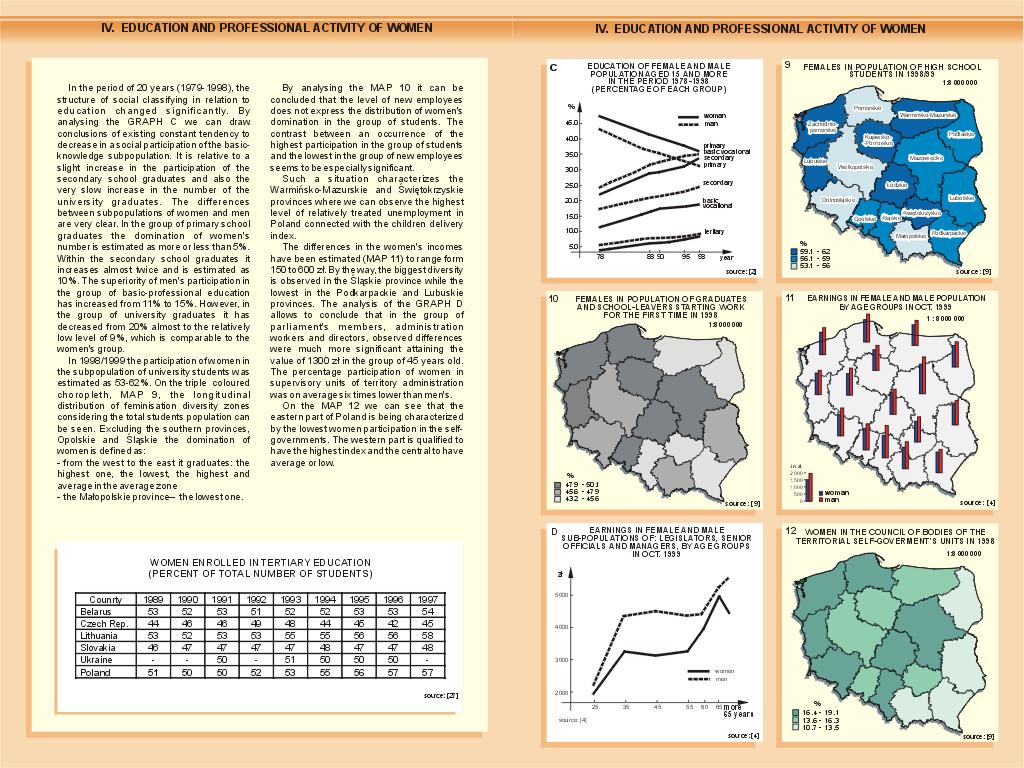 |
C. Education of female and male population aged 15 and more in the period 1978-1998 (percentage of each group)
9. Females in population of high school students in 1998/1999
10. Females in population in graduates and school-leavers starting work for the first time in 1998
11. Earnings in female and male population by age groups in Oct. 1999
D. Earnings in female and male sub-populations of: legislators, senior officials and managers by age groups in Oct. 1999
12. Women in the council of bodies of the territorial self-government's units in 1998
| V. MATERNITY - AGE AND PROFESSIONAL ACTIVITY OF THE MOTHERS |
|
13. Total fertility rate in 1998
14. Decrease in demographic rate (d.d.r.) from 1990 to 1998
E. Births by age and main source of maintenance of mother in 1998
| VI. MOTHERHOOD - AGE, PLACE OF RESIDENCE AND LEVEL OF EDUCATION OF MOTHER IN 1998 |
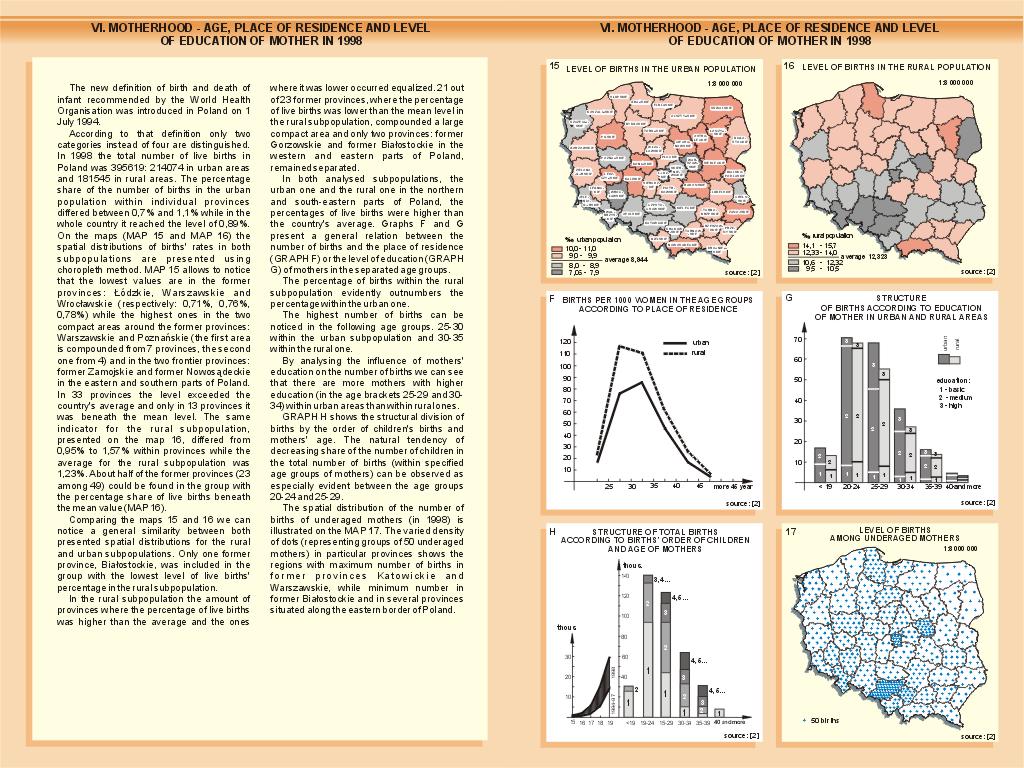 |
15. Level of births in urban population
16. Level of births in rural population
F. Births per 1000 women in the age groups according to place of residence
G. Structure of births in rural areas according to education of mother in urban and rural areas
H. Structure of total births according to births' order of children and age of mothers
17. Level of births among underage mothers
| VII. MOTHERHOOD AND FAMILY STATUS |
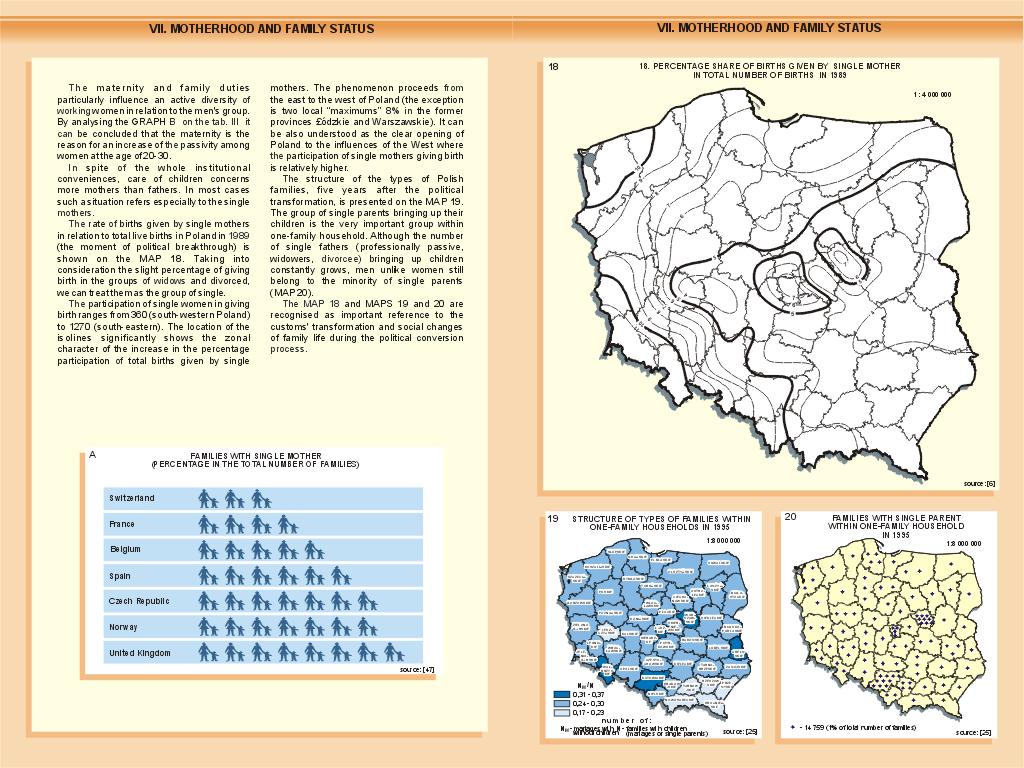 |
18. Percentage share of births given by single mother in total number of births in 1989
19. Structure of types of families within one-family households in 1995
20. Families with single parent (within one-family households) in 1995
| VIII. MOTHERHOOD AND SINGLE CARE OF CHILDREN |
|
21. Percentage share of birth given by single mother in total number of births in 1999
22. Female and male single care for children in urban areas in 1995
23. Female and male single care for children in rural areas in 1995
| IX. DENOMINATIONS' MINORITIES IN 1999 |
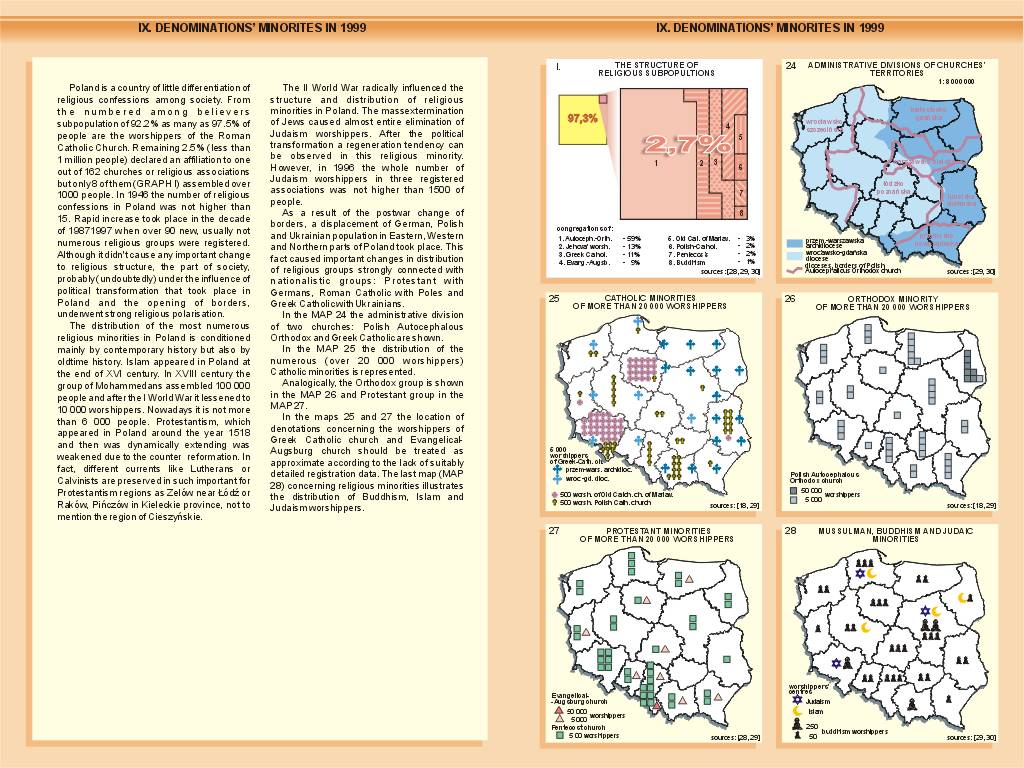 |
I. The structure of religious subpopulations
24. Administrative divisions of churches' territories
25. Catholic minorities of more than 20000 worshippers
26. Orthodox minorities of more than 20000 worshippers
27. Protestant minorities of more than 20000 worshippers
28. Muslim, Buddhism and Judaic minorities
B. GROUPS WITH SPECIAL CARTOGRAPHIC NEEDS
A. Population of children attending pre-school education establishments in 1945-1998
1. Children attending pre-school education establishments in 1999/2000
2. Children attending pre-school education establishments per 1000 children aged 3-6 in 1998 and 1999
3. Children aged 6-7 in pre-school education establishments in urban and rural areas in 1998/1999
4. Children in pre-school departments inside primary schools in urban and rural areas in 1998/1999
| II. AGE STRUCTURE OF POPULATION OF PUPLIS AND YOUTH AGED (6-20) ATTENDING PRIMARY AND LOWER SECONDARY SCHOOLS |
|
5. Pupils of primary and lower secondary schools in the school year 1999/2000 by basic age groups
B. Pupils of primary schools in the period 1990/1991-1999/2000 by gender
6. Pupils of primary schools for children and youth in the school year 1999/2000
| III. PHYSIOLOGICAL AND INTELLECTUAL CONDITIONS OF PROMARY EDUCATION OF PUPILS IN THE SCHOOL; YEAR 1999/2000 EXCLUDING PUPILS OF SPECIAL SCHOOLS |
|
7. Gender structure of pupils aged 7-12
8. Gender structure of pupils aged 13-15
9. Disabled pupils in classes I-VI of schools for children and youth
10. Ratio of disabled pupils to whole group of pupils in classes I-IV
11. Disabled girls in the group of disabled pupils in classes I-VIII
12. Intellectually disabled pupils of primary schools
| IV. PHYSIOLOGICAL AND ENVIRONMENTAL CONDITIONS OF PRIMARY EDUCATION OF PUPILS IN THE SCHOOL YEAR 1999/2000 |
|
C. Pupils in special types of schools
13. Pupils in special schools
14. Pupils educated in special primary schools urban sub-populations
15. Pupils educated in special primary schools rural sub-population
D. Pupils educated in special primary school by kind of disability
16. Visually impaired pupils in special primary school
| V. ADULTS AND PHYSIOLOGICAL LIMITATIONS OF MAP'S PERCEPTION - THE GROUP OF PEOPLE AGED 60 AND OVER |
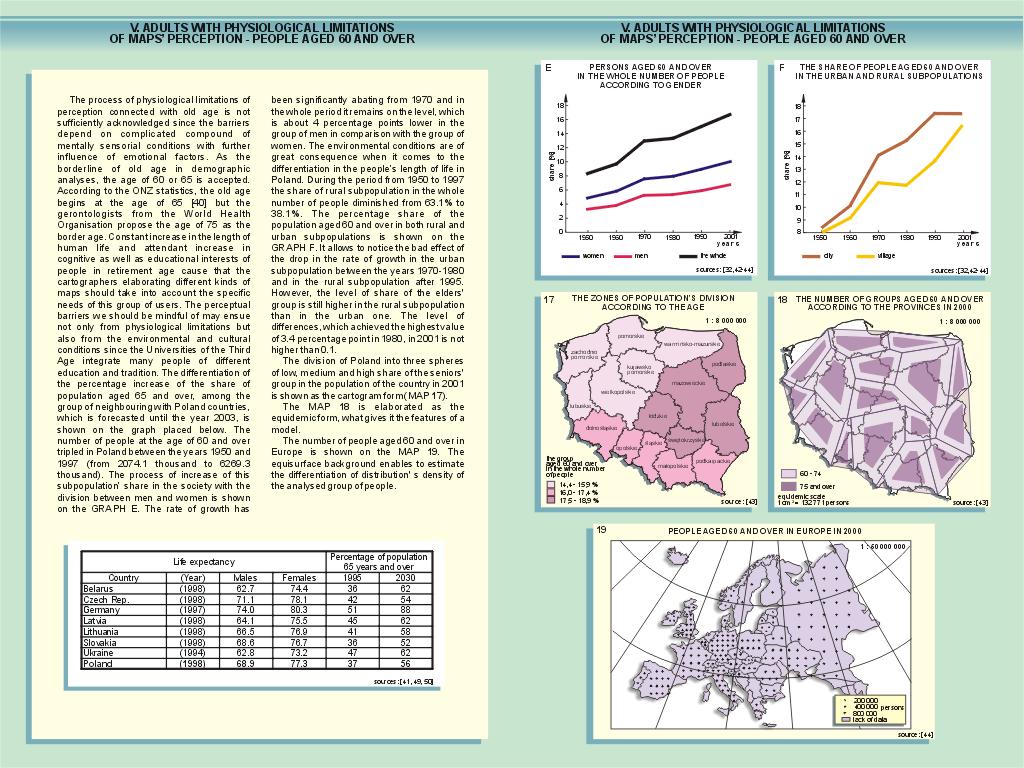 |
E. Persons aged 60 and over in the whole number of people according to gender
F. The share of people aged 60 and over in the urban and rural subpopulations
17. The zones of population's division according to age
18. The number of groups aged 60 and over according to the provinces in 2001
19. People aged 60 and over in Europe in 2000
| VI. ADULTS WITH PHYSIOLOGICAL LIMITATIONS OF MAP'S PERCEPTION - THE BLIND AND VISUALLY IMPAIRED PEOPLE |
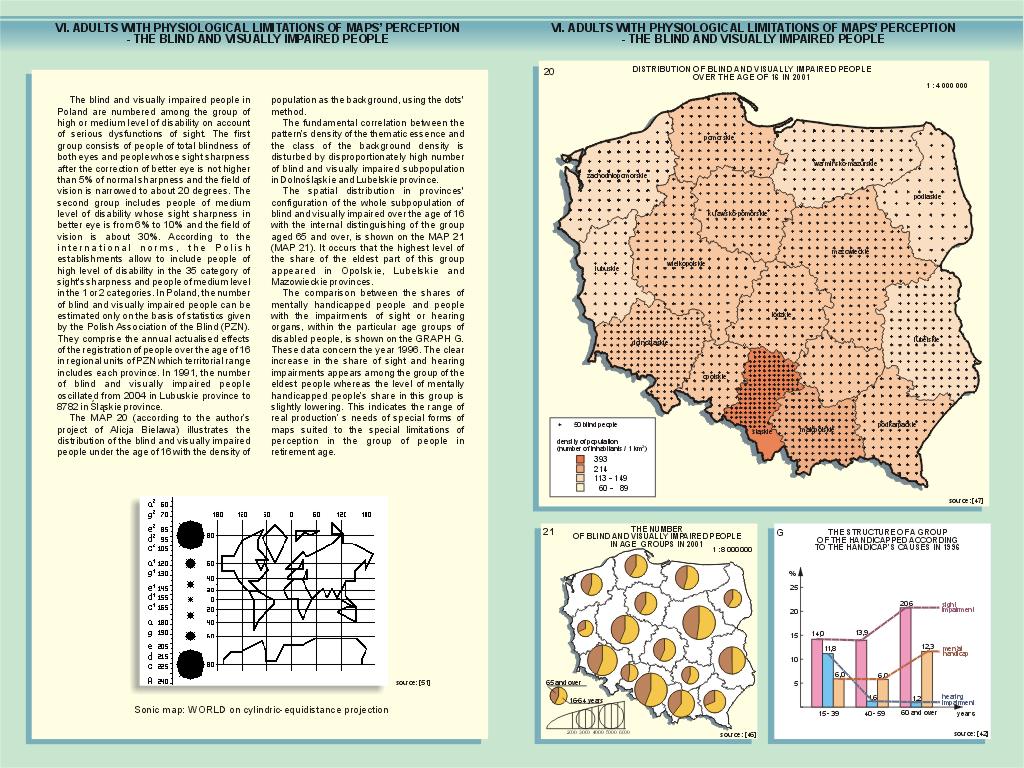 |
20. Distribution of blind and visually impaired people over the age 16 in 2001
21. The number of blind and visually impaired people in age groups in 2001
G. The structure of a groups of the handicapped according to the handicap's causes in 1996
| VII. LANGUAGE AND EDUCATIONAL CONDITIONS OF MAP'S PERCEPTION - THE GROUPS OF PEOPLE OF NOT POLISH LANGUAGE TRADITIONS |
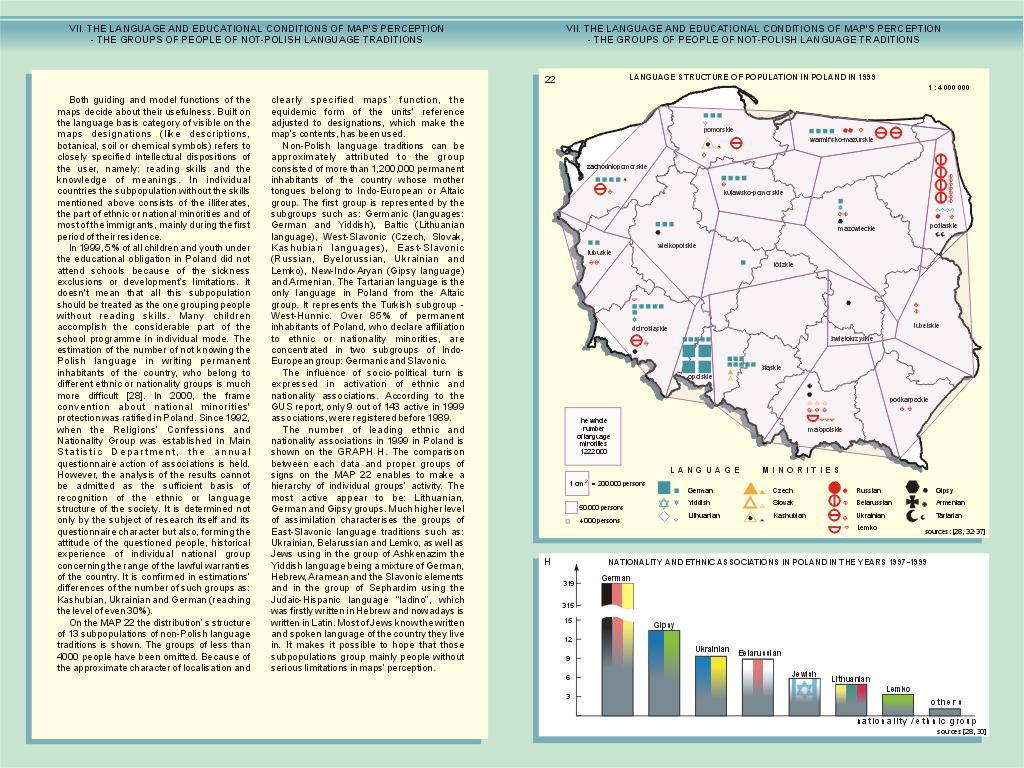 |
22. Language structure of population in Poland in 1999
H. Nationality and ethnic associations in Poland in the years 1997-1999
| VIII. LANGUAGE AND EDUCATIONAL CONDITIONS OF MAP'S PERCEPTION - IMMIGRANTS AND EMIGRANTS |
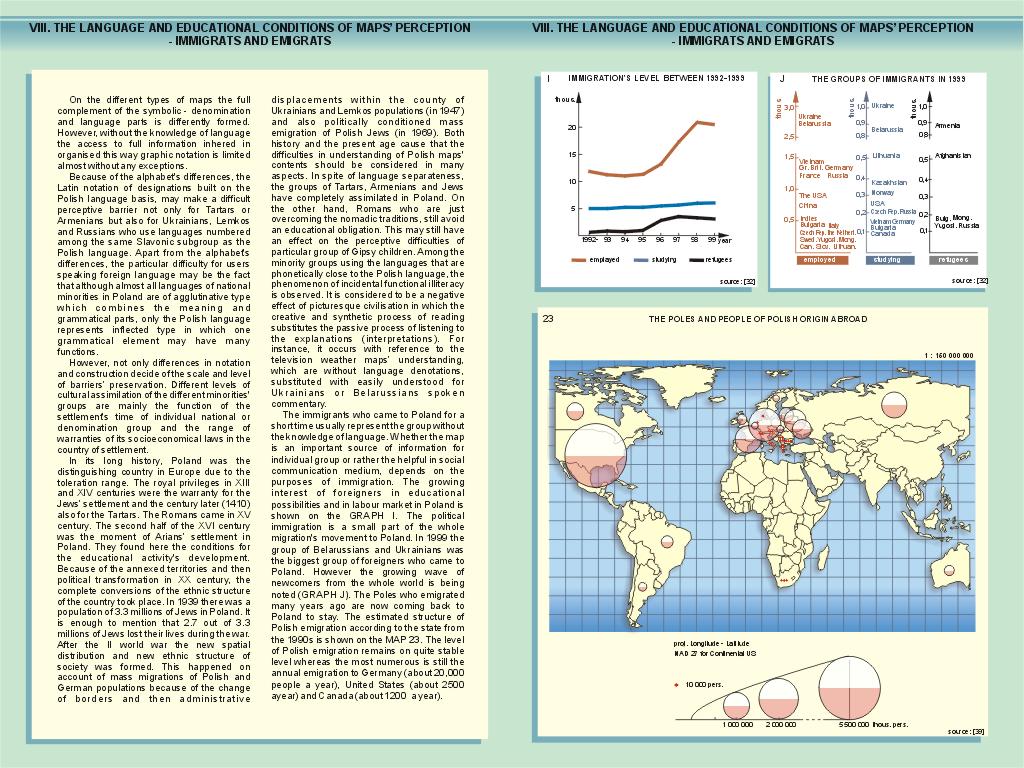 |
I. Immigration's level between 1992-1999
J. The groups of immigrants in 1999
23. The Poles and people of Polish origin abroad
| IX. OPERATIONAL CONDITIONS OF MAPS' PERCEPTION |
|
K. Persons aged 60 and over in the whole number of people according to gender
24.
25.
Kirsi Virrantaus:
Dear Ewa,
It was very nice to meet you and other Commission members once again in
Beijing. It is pity that everybody were so busy, so that we couldnt have
our traditional ladies luncheon. Maybe in Durban we have more time also
for social things and can talk more together.
I have sent you the Atlas manuscript and also a written note about what
EC decided on the matter. You will receive the papers soon, I suppose. I
can try to write here the main message from EC:
- EC was positive for printing the atlas as an example of a product thatt
can later be prepared in different countries
- for financing the atlas you may use your budget of the commission - please,
consult Ferjan Ormeling for this
- Mike Wood was willing to read the English, if needed
- they wanted that you present a paper on the atlas in Durban, you also
should organize at least one session in which gender-oriented topics are
presented
- they also reminded that you should check the terms of reference and be
sure that all of the issues are dealt with in you commission.
This is very shortly what they said. But, they accepted printing, which
is the main thing. Please, contact Ferjan Ormeling for the practical
things.
I wish you a good fall term.
With best regards
Kirsi
30.08.2001
|